Mechanisms of CO and CO2 Production during the Low-Temperature Oxidation of Coal: Molecular Simulations and Experimental Research
Abstract
:1. Introduction
- ①
- The decomposition of oxygen-containing compounds within the coal releases CO and CO2, known as Pathway 1, which generally occurs in the thermal decomposition of coal under an inert atmosphere [17]. This pathway generally occurs in the thermal decomposition of coal in an inert atmosphere.
- ②
- The CO and CO2 released from the decomposition of surface oxides generated by the oxidation reaction is called Pathway 2.
2. Materials and Methods
2.1. Materials
2.2. DFT Calculation Method
2.3. TG-FTIR Experiment
3. Results and Discussion
3.1. Micro-Processes of CO and CO2 Production from Spontaneous Combustion of Coal and Their Thermodynamic Parameters
- (1)
- Burn-off reaction: A reaction that occurs between the molecular structure of coal and oxygen. This process can be summarized as a total reaction where coal and oxygen produce CO, CO2, and water molecules.
- (2)
- Coal oxidology adsorption process: The coal oxidation process at low temperatures reacts with oxygen to produce an unstable state, i.e., the chemisorption state. The unstable state cycle produces CO, CO2, and heat, and the heat further promotes the oxidation reaction to produce CO and CO2.
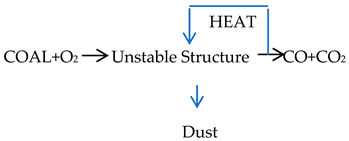
3.2. TG Characterization of Coal Oxidation at Low Temperature
- (1)
- Characteristic temperature point
- (2)
- Heat release analysis
- (3)
- Analysis of oxygen uptake and enthalpy of coal
- (4)
- Key thermodynamic parameters
3.3. Infrared Spectroscopy of Gas Products in Combustion Processes
3.4. Characterization of CO and CO2 Production during Low-Temperature Oxidation Processes
- (1)
- Phase I: gas desorption phase
- (2)
- Phase II: dynamic equilibrium phase
- (3)
- Phase III: oxygen adsorption phase
- (4)
- Phase IV: pyrolysis phase
4. Conclusions
Author Contributions
Funding
Institutional Review Board Statement
Informed Consent Statement
Data Availability Statement
Conflicts of Interest
References
- Kaminsky, V.A.; Obvintseva, N.Y.; Epshtein, S.A. The estimation of the kinetic parameters of low-temperature coal oxidation. AIMS Energy 2017, 5, 163–172. [Google Scholar] [CrossRef]
- Andreoli, S.; Eser, S. Relating reactivity to structure in cokes and carbon materials: Temperature-programmed oxidation and microscopy techniques. Carbon 2020, 168, 362–371. [Google Scholar] [CrossRef]
- Liu, L.; Jin, J.; Hou, F.; Li, S.; Lee, C.-H. Catalytic effects of calcium and potassium on a curved char surface in fuel reburning: A first-principles study on the adsorption of nitric oxide on single-wall carbon nanotubes with metal decoration. Energy 2017, 125, 459–469. [Google Scholar] [CrossRef]
- Zhai, X.; Ge, H.; Shu, C.-M.; Obracaj, D.; Wang, K.; Laiwang, B. Effect of the heating rate on the spontaneous combustion characteristics and exothermic phenomena of weakly caking coal at the low-temperature oxidation stage. Fuel 2020, 268, 117327. [Google Scholar] [CrossRef]
- Zhang, L.; Sun, X.; Li, B.; Xie, Z.; Guo, J.; Liu, S. Experimental and molecular dynamics simulation study on the enhancement of low rank coal flotation by mixed collector. Fuel 2020, 266, 117046. [Google Scholar] [CrossRef]
- Zhang, Z.; Kang, Q.; Yun, T.; Yan, K. Density Functional Theory Investigation of Possible Structures of Radicals in Coal Undergoing O2 Chemisorption at Ambient Temperature. Energy Fuels 2016, 31, 953–958. [Google Scholar] [CrossRef]
- Zhao, P.; Zhang, G.; Sun, Y.; Xu, Y. A review of oxygen removal from oxygen-bearing coal-mine methane. Environ. Sci. Pollut. Res. 2017, 24, 15240–15253. [Google Scholar] [CrossRef] [PubMed]
- Arisoy, A.; Beamish, B. Reaction kinetics of coal oxidation at low temperatures. Fuel 2015, 159, 412–417. [Google Scholar] [CrossRef]
- Wang, H.; Dlugogorski, B.Z.; Kennedy, E.M. Coal oxidation at low temperatures: Oxygen consumption, oxidation products, reaction mechanism and kinetic modelling. Prog. Energy Combust. Sci. 2003, 29, 487–513. [Google Scholar] [CrossRef]
- Karsner, G.G.; Perlmutter, D.D. Model for coal oxidation kinetics. 1. Reaction under chemical control. Fuel 1982, 61, 29–34. [Google Scholar] [CrossRef]
- Tan, B.; Cheng, G.; Zhu, X.; Yang, X. Experimental Study on the Physisorption Characteristics of O2 in Coal Powder are Effected by Coal Nanopore Structure. Sci. Rep. 2020, 10, 6946. [Google Scholar] [CrossRef] [PubMed]
- Zhong, X.X.; Wang, D.M.; Lu, W.; Xin, H.H. Oxygen Physisorption Characteristics of Coal. Mater. Sci. Forum 2011, 704–705, 897–902. [Google Scholar] [CrossRef]
- Ren, S.-J.; Wang, C.-P.; Xiao, Y.; Deng, J.; Tian, Y.; Song, J.-J.; Cheng, X.-J.; Sun, G.-F. Thermal properties of coal during low temperature oxidation using a grey correlation method. Fuel 2020, 260, 116287. [Google Scholar] [CrossRef]
- Lei, Z.; Yang, D.; Zhang, Y.-H.; Cui, P. Constructions of coal and char molecular models based on the molecular simulation technology. J. Fuel Chem. Technol. 2017, 45, 769–779. [Google Scholar] [CrossRef]
- Wang, D.; Zhong, X.; Gu, J.; Qi, X. Changes in active functional groups during low-temperature oxidation of coal. Min. Sci. Technol. China 2010, 20, 35–40. [Google Scholar] [CrossRef]
- Qi, X.; Wang, D.; Xin, H.; Zhong, X. Environmental Hazards of Coal Fire and Their Prevention in China. Environ. Eng. Manag. J. 2013, 12, 1915–1919. [Google Scholar] [CrossRef]
- Wang, J.T.; Wang, F.S.; Xu, Y.Y.; Dong, X. Study on Current Situation and Development Trend for Coal Mine Fire Prevention Technology in China. Fresenius Environ. Bull. 2019, 28, 5010–5016. [Google Scholar]
- Zhou, D.; Lu, W.; Li, J.; Song, Y.; Wu, C. Reactive adsorption mechanism of O2 onto coal vitrinite during the low temperature oxidation process. Fuel 2022, 308, 121802. [Google Scholar] [CrossRef]
- Lee, S.; Fischer, T.B.; Stokes, M.R.; Klingler, R.J.; Ilavsky, J.; McCarty, D.K.; Wigand, M.O.; Derkowski, A.; Winans, R.E. Dehydration Effect on the Pore Size, Porosity, and Fractal Parameters of Shale Rocks: Ultrasmall-Angle X-ray Scattering Study. Energy Fuels 2014, 28, 6772–6779. [Google Scholar] [CrossRef]
- Tan, B.; Cheng, G.; Fu, S.; Wang, H.; Li, Z.; Zhang, X. Molecular simulation for physisorption characteristics of O2 in low-rank coals. Energy 2022, 242, 122583. [Google Scholar] [CrossRef]
- Song, S.; Qin, B.; Xin, H.; Qin, X.; Chen, K. ExpSloring effect of water immersion on the structure and low-temperature oxidation of coal: A case study of Shendong long flame coal, China. Fuel 2018, 234, 732–737. [Google Scholar] [CrossRef]
- Huang, Z.; Zhao, X.; Gao, Y.; Shao, Z.; Zhang, Y.; Liu, X. The Influence of Water Immersion on the Physical and Chemical Structure of Coal. Combust. Sci. Technol. 2020, 194, 1136–1154. [Google Scholar] [CrossRef]
- Deng, J.; Ren, L.F.; Ma, L.; Qin, X.-Y.; Wang, W.-F.; Liu, C.-C. Low-temperature oxidation and reactivity of coal in O2/N2 and O2/CO2 atmospheres, a case of carboniferous-permian coal in Shaanxi, China. Environ. Earth Sci. 2019, 78, 234. [Google Scholar] [CrossRef]
- Avila, W.T. Estimating the Spontaneous Combustion Potential of Coals Using Thermogravimetric Analysis. Energy Fuels 2014, 49, 664–675. [Google Scholar] [CrossRef]
- Dey, S. Enhancement in hydrophobicity of low rank coal by surfactants—A critical overview. Fuel Process. Technol. 2012, 94, 151–158. [Google Scholar] [CrossRef]
- Qu, Z.; Sun, F.; Gao, J.; Pei, T.; Qie, Z.; Wang, L.; Pi, X.; Zhao, G.; Wu, S. A new insight into the role of coal adsorbed water in low-temperature oxidation: Enhanced·OH radical generation—ScienceDirect. Combust. Flame 2019, 208, 27–36. [Google Scholar] [CrossRef]
- Mazumder, S.; Hemert, P.V.; Busch, A.; Wolf, K.-H.A.A.; Tejera-Cuesta, P. Flue gas and pure CO2 sorption properties of coal: A comparative study. Int. J. Coal Geol. 2006, 67, 267–279. [Google Scholar] [CrossRef]
- Ottiger, S.; Pini, R.; Storti, G.; Mazzotti, M. Measuring and modeling the competitive adsorption of CO2, CH4, and N2 on a dry coal. Langmuir 2008, 24, 9531–9540. [Google Scholar] [CrossRef]
- Zhang, L.; Wu, D.; Cai, L.; Zou, C.; Qiu, J.; Zheng, C. The chemical and physical effects of CO2 on the homogeneous and heterogeneous ignition of the coal particle in O2/CO2 atmospheres. Proc. Combust. Inst. 2017, 36, 2113–2121. [Google Scholar] [CrossRef]
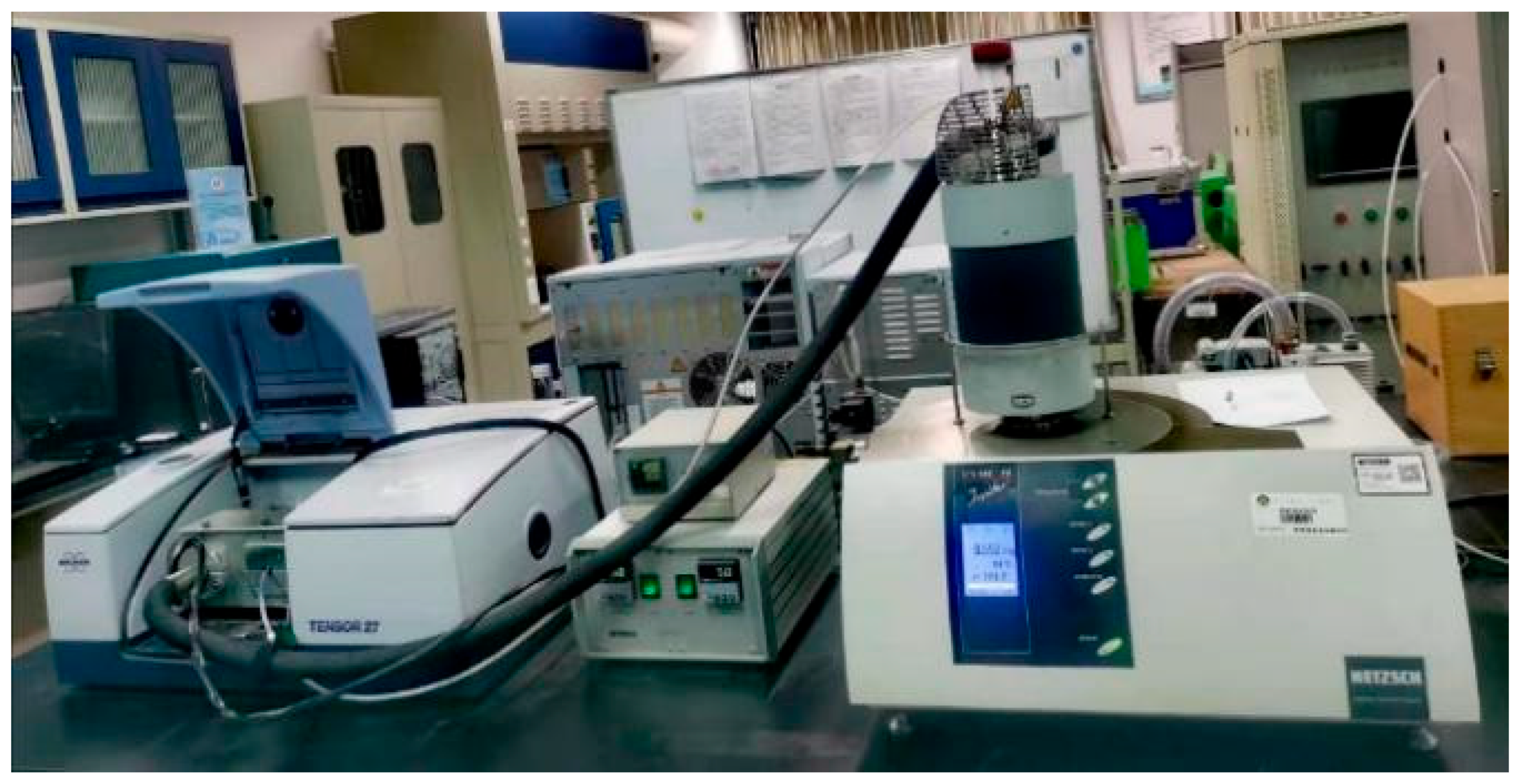

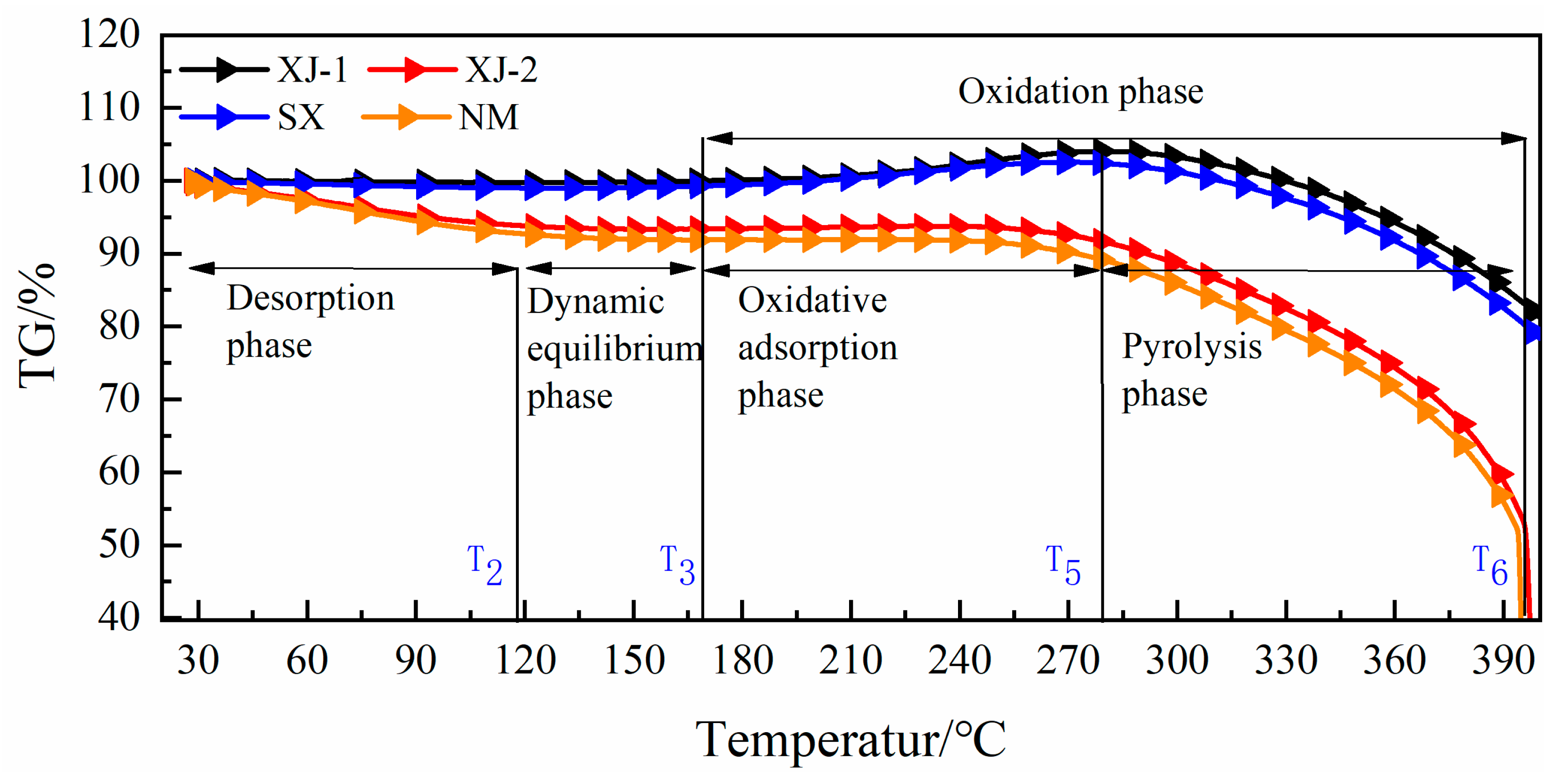



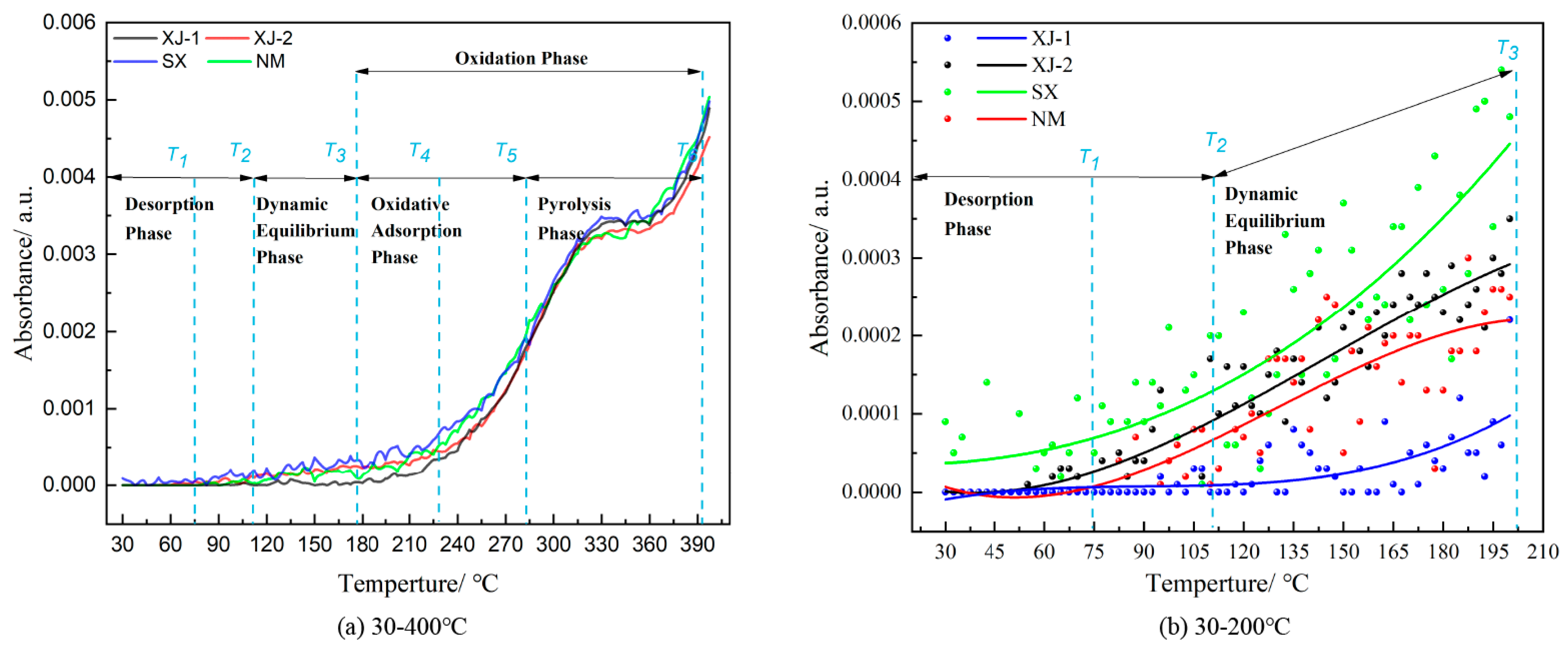
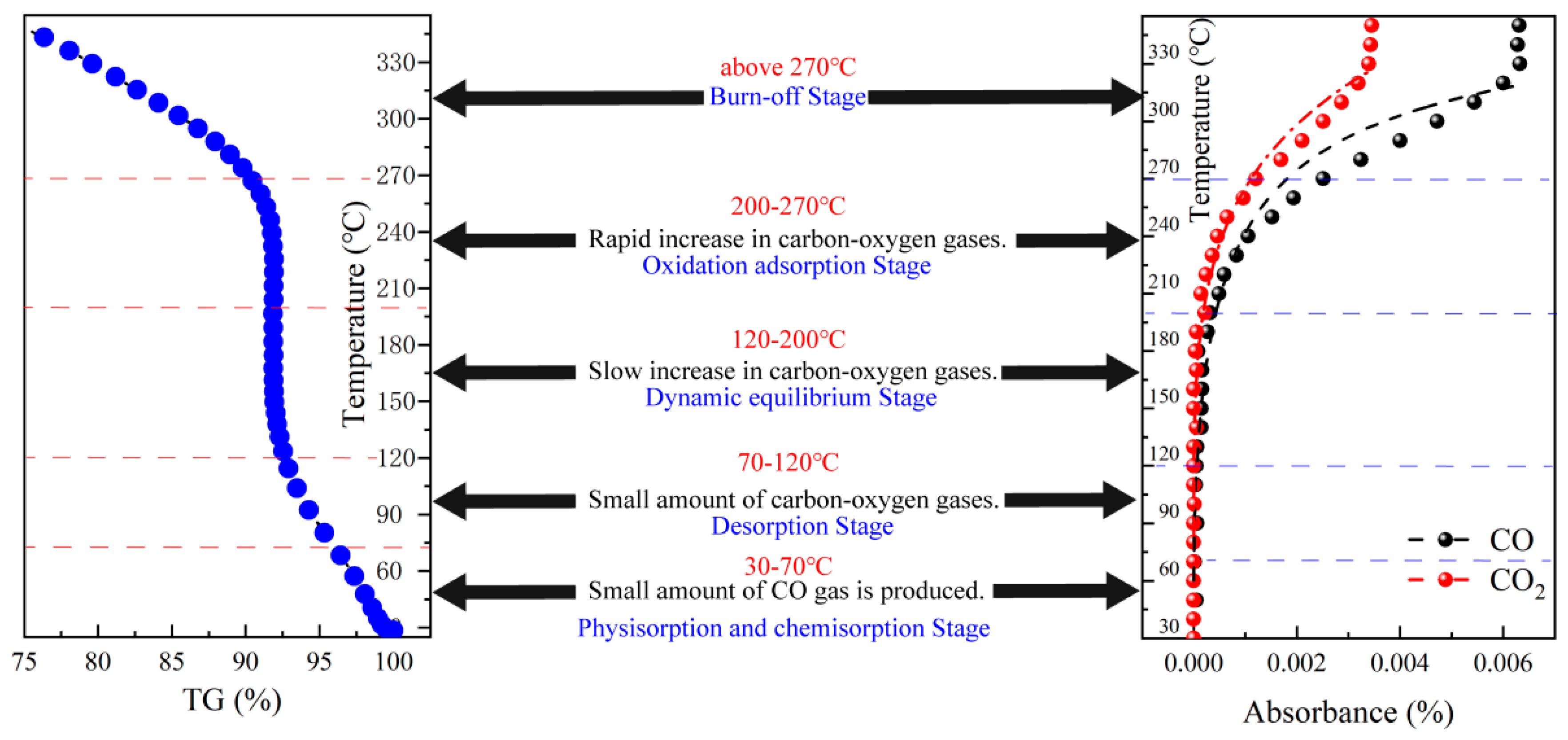
| Sample | Industrial Analysis/% | Element Analysis/% | True Density/g·cm−3 | Type | ||||||
|---|---|---|---|---|---|---|---|---|---|---|
| Mad | Ad | Vdaf | Cdaf | Hdaf | Ndaf | Odaf | Sdaf | |||
| XJ-1 | 0.77 | 10.41 | 38.82 | 85.87 | 5.66 | 1.53 | 6.33 | 0.56 | 1.36 | Gas coal |
| XJ-2 | 8.45 | 3.50 | 32.13 | 79.94 | 4.17 | 0.61 | 14.95 | 0.25 | 1.48 | Jet coal |
| SX | 2.67 | 13.18 | 36.09 | 81.50 | 4.94 | 0.96 | 9.34 | 2.77 | 1.48 | Weak caking |
| NM | 13.72 | 7.27 | 42.64 | 74.29 | 4.97 | 1.02 | 18.08 | 1.24 | 1.50 | Lignite |
| Thermodynamic Parameter | STEP 2 | STEP 3 | STEP 4 | STEP 5-1 | STEP 5-2 |
|---|---|---|---|---|---|
| activation energy ΔE (kJ/mol) | 0 | 59.71 | 23.51 | 32.11 | 73.53 |
| exothermic heat ΔH (kJ/mol) | −142.33 | −157.33 | 18.91 | −17.83 | 57.71 |
| Phase | Desorption | Dynamic Equilibrium | Oxidative Adsorption | Pyrolysis | ||
|---|---|---|---|---|---|---|
| T1/°C | T2/°C | T3/°C | T4/°C | T5/°C | T6/°C | |
| XJ-1 | 72.53 | 110.63 | 174.44 | 220.12 | 272.22 | 383.22 |
| XJ-2 | 72.65 | 123.24 | 182.33 | 214.03 | 250.52 | 333.65 |
| SX | 70.88 | 120.15 | 170.54 | 225.14 | 270.41 | 399.15 |
| NM | 70.12 | 116.11 | 171.06 | 210.55 | 243.23 | 325.61 |
| Parameters | XJ-1 | XJ-2 | SX | NM |
|---|---|---|---|---|
| Enthalpy H (J/g) | −1235.93 | −982.24 | −1113.41 | −1060.41 |
| Oxygen uptake Q (%) | 3.59 | −5.39 | 2.74 | −7.21 |
| Phase | XJ-1 | SX | XJ-2 | NM | ||||
|---|---|---|---|---|---|---|---|---|
| E (kJ/min) | A (min−1) | E (kJ/min) | A (min−1) | E (kJ/min) | A (min−1) | E (kJ/min) | A (min−1) | |
| 1. Dynamic change | 0.843 | 4.7 × 101 | 1.005 | 6.7 × 101 | 0.998 | 6.6 × 101 | 0.976 | 6.3 × 101 |
| 2. Weight gain through oxygenation | 3.487 | 1.7 × 102 | 3.973 | 1.8 × 102 | 3.618 | 1.5 × 102 | 3.481 | 1.4 × 102 |
| 3. Pyrolysis | 88.918 | 7.9 × 1010 | 100.501 | 2.8 × 1012 | 94.091 | 6.0 × 1012 | 56.283 | 2.8 × 10⁷ |
| Feature Type | Phase I | Phase II | Phase III | Phase IV |
|---|---|---|---|---|
| 30–120 °C | 120–180 °C | 180–300 °C | 300–400 °C | |
| Oxygen uptake | Less | Less | More | Most |
| activation energy | Positive | Negative | Positive | Negative |
| Heat absorption and release | Endothermic | Exothermic | Exothermic | Exothermic |
| Mass | Decrease | Decrease | Increase | Increase |
| Gas | Degassing performance CO starts to be produced, and the desorbed gas is dominated by moisture | Degassing performance CO2 starts to be produced, and the desorbed gas is dominated by moisture | Oxygen intake followed by degassing performance Gas production begins to increase | Oxygen uptake performance Maximum gas production |
Disclaimer/Publisher’s Note: The statements, opinions and data contained in all publications are solely those of the individual author(s) and contributor(s) and not of MDPI and/or the editor(s). MDPI and/or the editor(s) disclaim responsibility for any injury to people or property resulting from any ideas, methods, instructions or products referred to in the content. |
© 2023 by the authors. Licensee MDPI, Basel, Switzerland. This article is an open access article distributed under the terms and conditions of the Creative Commons Attribution (CC BY) license (https://creativecommons.org/licenses/by/4.0/).
Share and Cite
Wang, Y.; Sun, Y.; Dai, L.; Wang, K.; Cheng, G. Mechanisms of CO and CO2 Production during the Low-Temperature Oxidation of Coal: Molecular Simulations and Experimental Research. Fire 2023, 6, 475. https://doi.org/10.3390/fire6120475
Wang Y, Sun Y, Dai L, Wang K, Cheng G. Mechanisms of CO and CO2 Production during the Low-Temperature Oxidation of Coal: Molecular Simulations and Experimental Research. Fire. 2023; 6(12):475. https://doi.org/10.3390/fire6120475
Chicago/Turabian StyleWang, Yongjing, Yong Sun, Lihui Dai, Kun Wang, and Gang Cheng. 2023. "Mechanisms of CO and CO2 Production during the Low-Temperature Oxidation of Coal: Molecular Simulations and Experimental Research" Fire 6, no. 12: 475. https://doi.org/10.3390/fire6120475
APA StyleWang, Y., Sun, Y., Dai, L., Wang, K., & Cheng, G. (2023). Mechanisms of CO and CO2 Production during the Low-Temperature Oxidation of Coal: Molecular Simulations and Experimental Research. Fire, 6(12), 475. https://doi.org/10.3390/fire6120475








